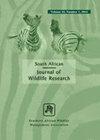Bat Activity Across South Africa: Implications for Wind Energy Development
引用次数: 2
Abstract
We provide a comparison of bat activity levels recorded during long-term acoustic monitoring through 188 microphones at pre-construction wind energy facility (WEF) sites in 12 South African ecoregions, and discuss the implications of the results for wind energy development. We summed all bat passes and detector hours over microphones, sites and years for each month, and fitted a negative binomial regression model with total bat passes as the response and ecoregion as the predictor. Overall, there was a significant effect of ecoregion on the number of bat passes per detector hour recorded near ground level, and in the turbine rotor sweep. Pairwise comparisons revealed that the sites in Maputaland coastal forests and woodlands, and KwaZulu-Natal-Cape coastal forests, were most distinct due to exceptionally high levels of recorded activity. As such, we strongly advise against WEF development in these ecoregions. In lowland fynbos and renosterveld, Limpopo lowveld, and Albany thickets, where intermediate to high bat activity was recorded, we recommend that the conditions of WEF-authorizations must include rigorous bat impact mitigation measures. For operational WEFs, our results provided valuable benchmark information for devising bat fatality thresholds that reflect the variation in bat activity across South Africa's diverse landscape.蝙蝠在南非的活动:对风能发展的影响
我们通过南非12个生态区施工前风能设施(WEF)场地的188个麦克风,对长期声学监测期间记录的蝙蝠活动水平进行了比较,并讨论了结果对风能开发的影响。我们总结了每个月麦克风、地点和年份的所有蝙蝠通过次数和探测器小时数,并拟合了一个负二项回归模型,以蝙蝠总通过次数为响应,生态区域为预测因子。总的来说,记录区域对地面附近和涡轮机转子扫掠中记录的每探测器小时蝙蝠通过次数有显著影响。成对比较显示,马普特兰海岸森林和林地以及夸祖鲁-纳塔尔角海岸森林的地点最为明显,因为记录的活动水平异常高。因此,我们强烈建议不要在这些生态区域发展世界经济论坛。在低地fynbos和renosterveld、Limpopo lowveld和Albany灌木丛中,记录到中等至高蝙蝠活动,我们建议WEF授权的条件必须包括严格的蝙蝠影响缓解措施。对于可操作的WEF,我们的结果为设计蝙蝠死亡阈值提供了有价值的基准信息,该阈值反映了南非不同地区蝙蝠活动的变化。
本文章由计算机程序翻译,如有差异,请以英文原文为准。
求助全文
约1分钟内获得全文
求助全文

 求助内容:
求助内容: 应助结果提醒方式:
应助结果提醒方式:


